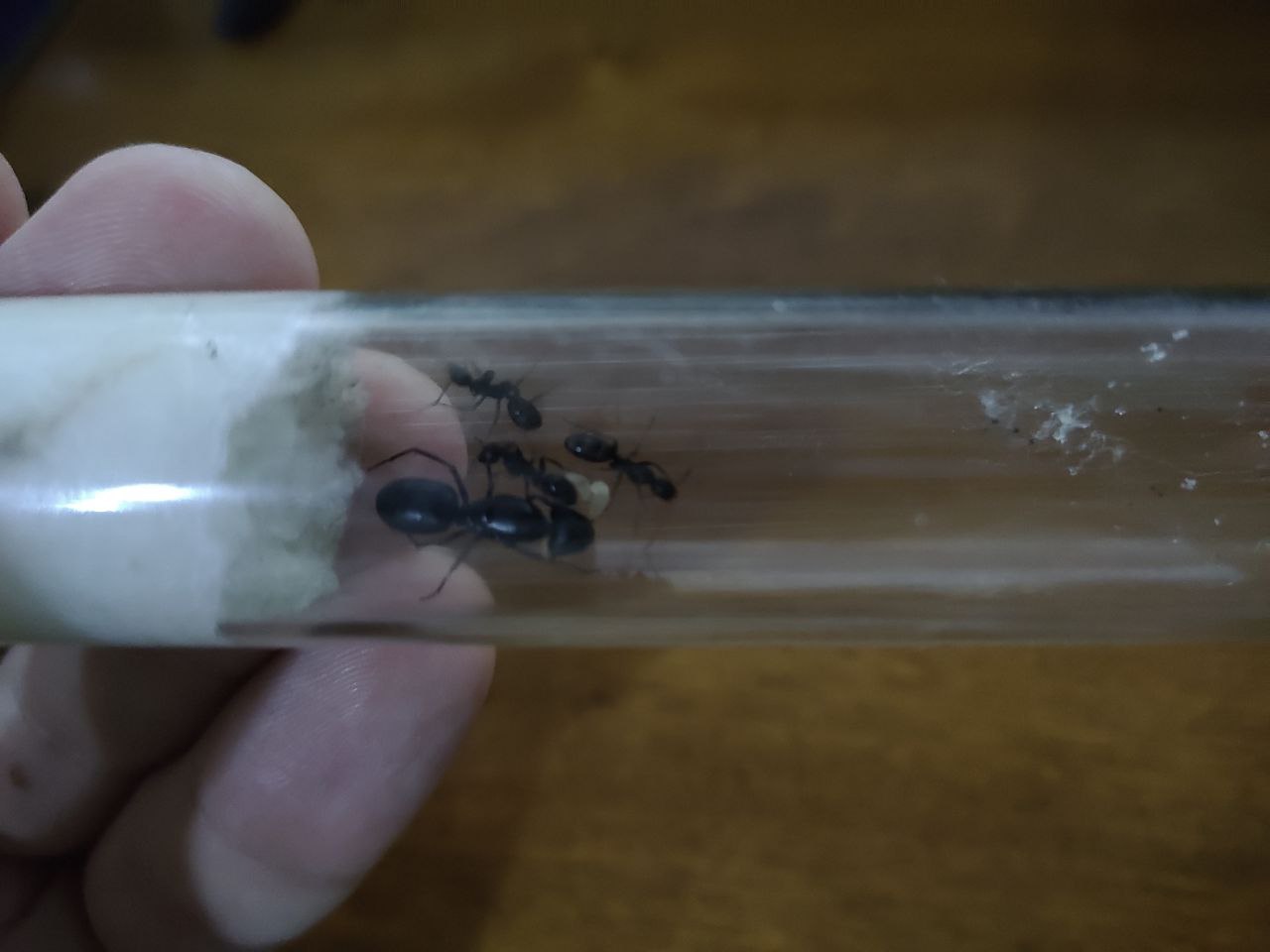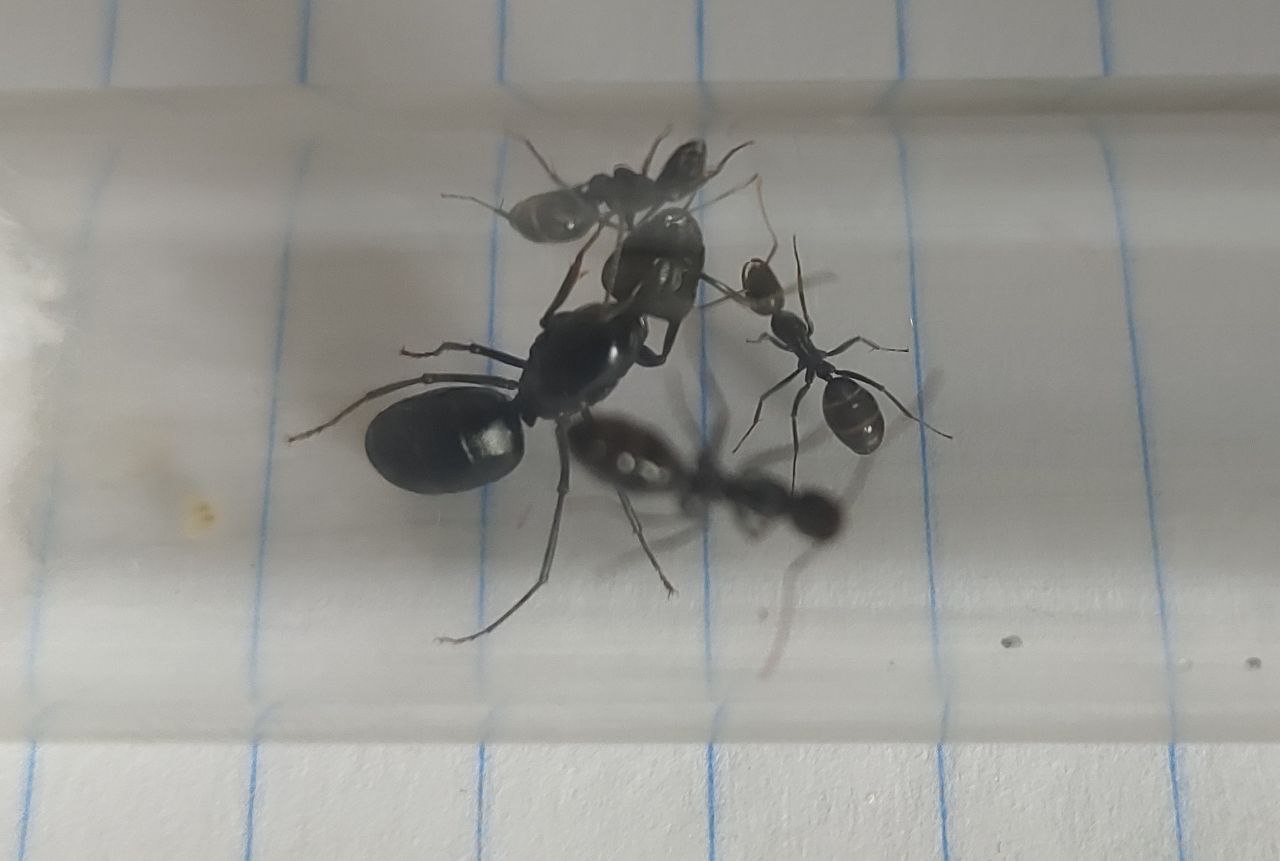- Formiculture.com
- Forums
- Gallery
- Members
- Member Map
- Chat

Camponotus Japonicus advice needed
Started By
Holuden
, Jun 7 2024 11:11 PM
question camponotus japonicus
8 replies to this topic
#1
 Offline
-
Posted June 7 2024 - 11:11 PM
Offline
-
Posted June 7 2024 - 11:11 PM
Hi. I'm semi-novice for ant keeping and would be most grateful for a comment on the following:
Two month ago I was given away a Camponotus Japonicus queen with 3 workers. At the time they were not kept in the dark, frequently bothered and for 2 month and probably were not fed. Naturally, there were no brood during this time.
When I got them, they were held in the dark for a week and then I moved them to a new test tube since old one had broken water reservoir. And while transfer, provided them with some honey. At that time there were two little eggs. (On the first pic, on the left)
Question is: after the first 2 weeks since transfer I checked on them and was glad to notice that eggs grew up a bit. After another two weeks noticed that the eggs didn't really grow at all. And month later she doesn't lay eggs and those old eggs do not undergo development.
They are kept in the dark, are not bothered and I will probably move them to another tube since it seems that mold starts to develop.
Should I provide them with protein source?
Would it be ok if I leave them in a formicarium prepared for them with tube being well covered but with small exit hole open?
#2
 Offline
-
Posted June 8 2024 - 6:35 AM
Offline
-
Posted June 8 2024 - 6:35 AM
That test tube is fine. They don’t have to be kept in the dark. As long as it’s warm and vibration free. They will need protein and sugar daily to get the queen laying again. This colony was not well taken care of. Colonies should always have brood of all stages. You have to keep in mind that for Camponotus egg to worker is like 2 months sometimes depends on temperature. Those are nanitics so they don’t live as long as older gen workers you are in need of new workers before the nanitics die off then it’s game over for this colony
#3
 Offline
-
Posted June 8 2024 - 10:16 AM
Offline
-
Posted June 8 2024 - 10:16 AM
Wow I feel really bad for that colony. Yep Kiedeerk is right in that depending on the temperature they might grow slower. Ants like heat!
I would probably still suggest keeping it in the dark, just to simulate their natural environment (in a piece of wood or underground) and give them some protein for sure. Mealworms, arthropods, or crickets are great options! Just feed them pretty small pieces, and maybe connect a very small outworld to it so they can forage and carry it back to the nest, and dispose of rotting pieces once they get old.
In terms of liquids, honey or sugar water is the best option most likely, but pretty much anything with sugar in it will boost and energize the workers, and encourage the queen to begin laying again.
Good luck, and I hope your colony establishes itself!
Currently raising:
Manica invidia (1 queen + ~30 workers)
Manica invidia (3 colonies, 3 queens plus brood)
Lasius niger (single queen + ~200+ workers)
Lasius americanus (3 colonies, ~5 workers p/colony)
Tetramorium immigrans (1 queen + ~1200 workers)
Tetramorium immigrans (3 colonies, 3 queens)
"I discovered that if one looks a little closer at this beautiful world, there are always red ants underneath."
- David Lynch
#4
 Offline
-
Posted June 8 2024 - 1:27 PM
Offline
-
Posted June 8 2024 - 1:27 PM
Give them some protein (some fruit flies, a fly or spider you found in the house (kill it first), etc.) and see if they take it. Also sugar water and normal water should be there at all times.
Camponotus japonicus can have a winter diapause (they don't become fully inactive but will have no brood development at all for up to 4 months), depending on where exactly it is from.
I'd recommed putting their test tube into a small box, that makes feeding much easier. They will take a long time to grow beyond 50 workers, so modularity/the abilty to expand that founding box setup isn't really required.
You can settle their tube over into a bigger setup once they've reached 30-40 workers.
Edited by Serafine, June 8 2024 - 1:31 PM.
We should respect all forms of consciousness. The body is just a vessel, a mere hull.
Welcome to Lazy Tube - My Camponotus Journal
#5
 Offline
-
Posted June 8 2024 - 3:53 PM
Offline
-
Posted June 8 2024 - 3:53 PM
Give them some protein (some fruit flies, a fly or spider you found in the house (kill it first), etc.) and see if they take it. Also sugar water and normal water should be there at all times.
Camponotus japonicus can have a winter diapause (they don't become fully inactive but will have no brood development at all for up to 4 months), depending on where exactly it is from.
I'd recommed putting their test tube into a small box, that makes feeding much easier. They will take a long time to grow beyond 50 workers, so modularity/the abilty to expand that founding box setup isn't really required.
You can settle their tube over into a bigger setup once they've reached 30-40 workers.
Camponotus sp usually diapause with brood in the form of small larva. Formica sp usually diapause with no brood at all.
#6
 Offline
-
Posted June 8 2024 - 4:04 PM
Offline
-
Posted June 8 2024 - 4:04 PM
They have two small larvae (as seen in the first picture). That's not much but also not spectacularly low for Camponotus standards.
My C. barbaricus had 4 workers and around 6 larvae during their first hibernation.
It's also worth noting that the egg-to-larva time frame for many Camponotus species can be up to four weeks and the egg-to-worker time frame can be anything between a month and two months (with pupation alone taking up to a month in some species), depending on species and temperature.
Camponotus larvae also grow in spurts (they only grow when they shed their skin, so it's not a continuous growth but instead a growth that comes in phases).
Edited by Serafine, June 8 2024 - 4:07 PM.
- Mushu likes this
We should respect all forms of consciousness. The body is just a vessel, a mere hull.
Welcome to Lazy Tube - My Camponotus Journal
#7
 Offline
-
Posted June 8 2024 - 4:43 PM
Offline
-
Posted June 8 2024 - 4:43 PM
They have two small larvae (as seen in the first picture). That's not much but also not spectacularly low for Camponotus standards.
My C. barbaricus had 4 workers and around 6 larvae during their first hibernation.
It's also worth noting that the egg-to-larva time frame for many Camponotus species can be up to four weeks and the egg-to-worker time frame can be anything between a month and two months (with pupation alone taking up to a month in some species), depending on species and temperature.
Camponotus larvae also grow in spurts (they only grow when they shed their skin, so it's not a continuous growth but instead a growth that comes in phases).
The problem is that this is likely a second year colony. Having only a couple nanitics with barely any brood and it’s mid June already. Usually you get about 15-20 workers by the first diapause if the colony is well taken care of.
#8
 Offline
-
Posted June 10 2024 - 10:48 PM
Offline
-
Posted June 10 2024 - 10:48 PM
They have two small larvae (as seen in the first picture). That's not much but also not spectacularly low for Camponotus standards.
My C. barbaricus had 4 workers and around 6 larvae during their first hibernation.
It's also worth noting that the egg-to-larva time frame for many Camponotus species can be up to four weeks and the egg-to-worker time frame can be anything between a month and two months (with pupation alone taking up to a month in some species), depending on species and temperature.
Camponotus larvae also grow in spurts (they only grow when they shed their skin, so it's not a continuous growth but instead a growth that comes in phases).
The problem is that this is likely a second year colony. Having only a couple nanitics with barely any brood and it’s mid June already. Usually you get about 15-20 workers by the first diapause if the colony is well taken care of.
I think we can all agree is was probably neglected, however Serafine definitely has a point depending on the species,individual queen,etc, they may be slower and if we include the diapause, it's not uncommon although not great.
I am a bit confused by the timeframe mentioned by OP:
"Two month ago I was given away a Camponotus Japonicus queen with 3 workers. At the time they were not kept in the dark, frequently bothered and for 2 month and probably were not fed"
I'm assuming they meant the previous owner had it for 2 months.
#9
 Offline
-
Posted June 11 2024 - 6:20 AM
Offline
-
Posted June 11 2024 - 6:20 AM
Thank you very much for your kind response and advice. I will refresh their nest and place it in small environment with protein and honey water.
They were purchased by the previous owner in early February from the dealer. They were given away to me in April. In mid. April I transfered them to a new tube. Eggs grew a little bit over the next two weeks but stopped growing since then.
Also tagged with one or more of these keywords: question, camponotus japonicus
Ant Keeping →
General Ant Keeping →
L.Niger test tube is too wetStarted by Mr.Fish , Jun 9 2024 |
|
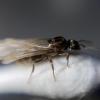
|
||
Ant Keeping →
General Ant Keeping →
My ants keep moving to the outworld?Started by Pokee5954 , Feb 18 2024 |
|

|
||
Ants & Myrmecology →
General →
Is it too early to consider another colony?Started by Pokee5954 , Dec 1 2023 |
|
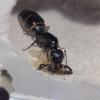
|
||
Termites →
Termite Keeping →
I don't know exactly how to start a termite colonyStarted by Bugging3out , May 1 2022 |
|
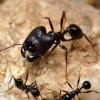
|
||
Ant Keeping →
General Ant Keeping →
How keep plaster formicarium mold free?Started by voylin , Aug 15 2021 |
|

|
1 user(s) are reading this topic
0 members, 1 guests, 0 anonymous users



